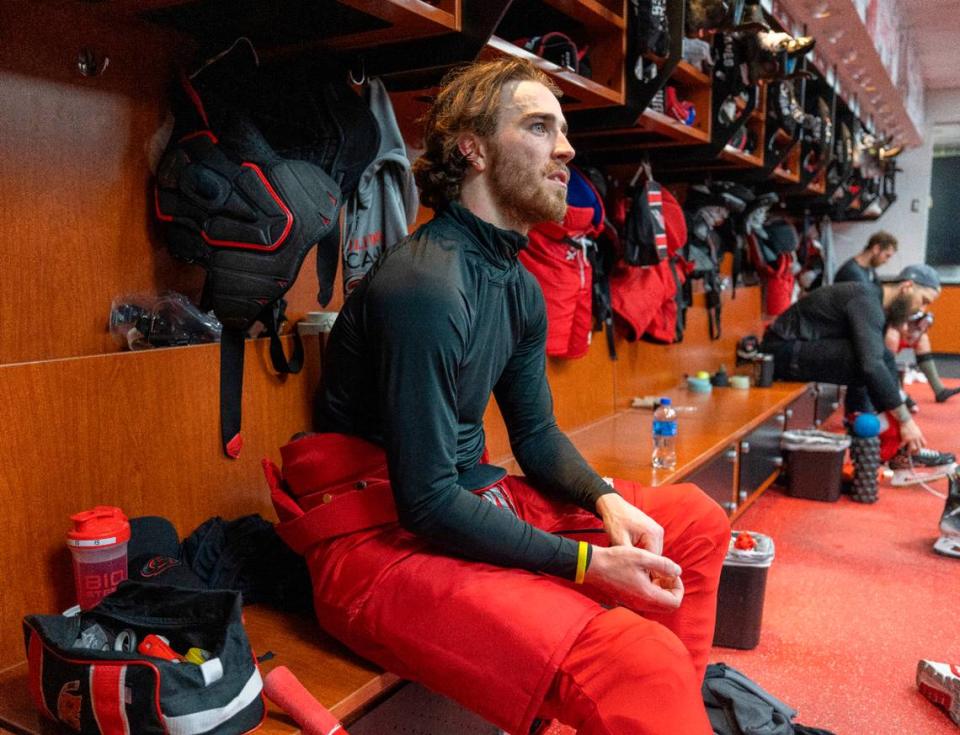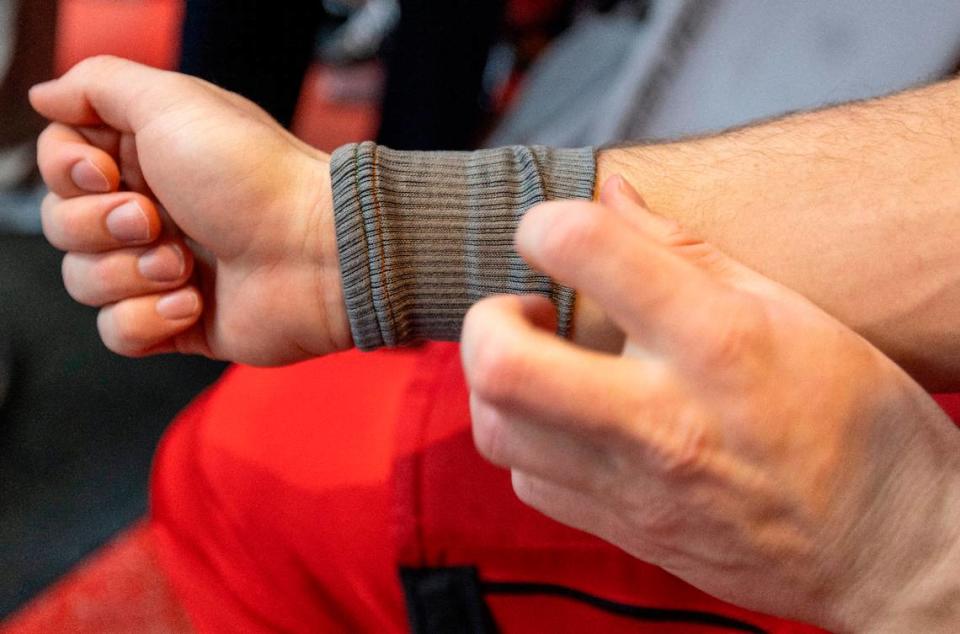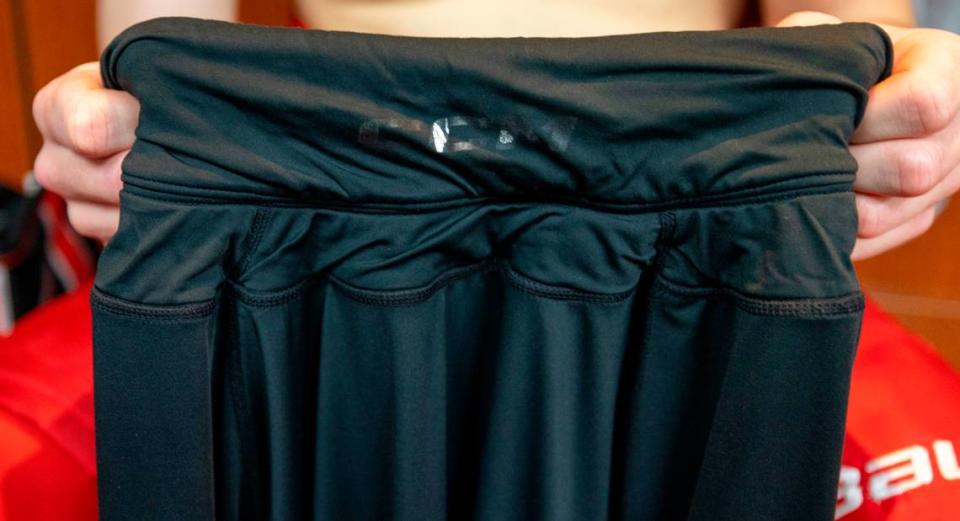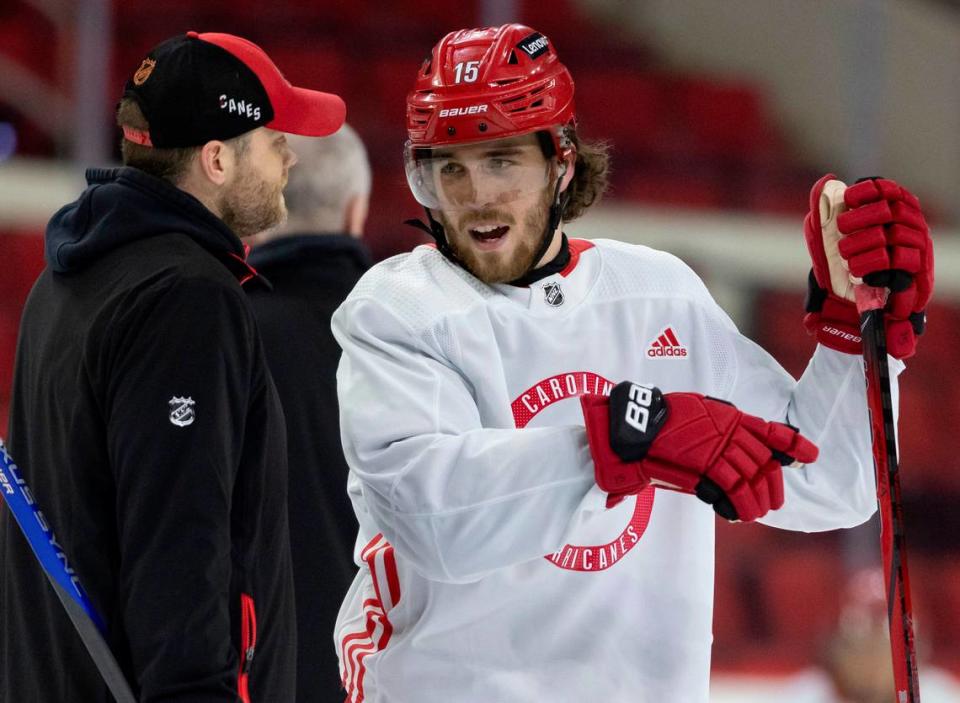NHL players slow to adopt neck guards. Why one Hurricanes defender wears one anyway
To the naked eye, it just looks like Dylan Coghlan is wearing a mock turtleneck under his pads, like European hockey players of old, Alexei Yashin or Tomas Plekanec. It’s not for style. Anything but. What he’s actually wearing is a high-tech undershirt woven with Kevlar fibers that could save his life.
Coghlan is the only player on the Carolina Hurricanes who wears neck protection, a hot topic in hockey circles since the January death of a player in the British pro league after his neck was cut by a skate. That’s always been one of the risks embedded in the game, going back to gruesome, bloody NHL near-misses that still make the rounds on YouTube, like those involving Clint Malarchuk or Richard Zednik.

When a skate blade whirred past Coghlan’s throat during an AHL game, close enough to feel the wind in its wake, that was that.
“My mom was hounding me if I would wear one and I kind of brushed it off,” Coghlan said. “My girlfriend asked me a couple times and I brushed it off again. Everyone just kept asking me, but now that I wear one now, I’ll probably wear one for the rest of my career.”
This year, after Adam Johnson’s death in England, both the International Ice Hockey Federation and USA Hockey made neck protection mandatory. But other than a few high-profile players — like Washington Capitals forward T.J. Oshie, whose apparel company Warroad makes the cut-protection undershirt he wears — few NHLers have followed suit, even as almost all wear Kevlar-impregnated socks and a few wear Kevlar sleeves on their wrists.

Initially, at midseason, the hockey supply chain couldn’t keep up with the sudden, new demand for neck protection, whether full undershirts or sleeves that go around the neck and under the shoulder pads. The Hurricanes have several types and brands available for any player who wants to add that extra layer of protection. Only Coghlan, who appeared in one Hurricanes game this season before joining the Hurricanes from the AHL for the playoffs, has chosen to do so.
“You never know,” Coghlan said. “Guys are going pretty hard out there and sometimes you lose the ability to know where your skates are going. It’s always better safe than sorry.”
A personal decision for hockey players
For now, as the outlier on the Hurricanes — he was not with his AHL club, where wearing neck guards was more common — it does make him the butt of jokes, like the first players to wear helmets and the first players to don visors, both of which have long been mandatory. There is, unavoidably, a macho aspect to this, not wanting to appear vulnerable or admit weakness.
But it’s also a deeply personal and professional question for hockey players, whose careers may depend on the finest margin of performance at the narrowest, farthest end of the bell curve, and are loathe to make any changes that could impact that. If a neck guard restricts their ability to turn their head, or hampers their ability to regulate their body temperature, who’s to say that won’t make a difference to an elite athlete at this level?

European players are more familiar with neck guards, most having grown up wearing them, but they also took the opportunity not to wear them when they came to North America. As long as players believe that little bit of mobility, that little bit of freedom, makes a competitive difference in an arena where the slightest edge could mean an extra goal or extra win (or an extra million), that will remain the case.
So it’s far easier for an outsider to ask, “Why take the risk?” In a fast-moving, physical, violent sport like hockey, players are constantly performing a personal, internal calculus, balancing the risks they take, with their health and their lives, every time they step onto the ice. The razor-sharp blades on their feet are almost the least of it. Almost all players wear the Kevlar socks that protect an area prone to skate cuts (and the Achilles tendon). Some wear the Kevlar wrist sleeves that protect the area above their gloves, which look like big, gray wristbands.
Even that is a balancing act. Jaccob Slavin started wearing the wrist sleeves this season, but he noted they make him substantially hotter when he plays and practices. So he’s willing to go that far, but not as far as his neck. At least not with this iteration of the gear, anyway.
“My younger brother (Josiah) wore it the whole year in the AHL,” Slavin said. “I’m not against it. But I guess it’s got to be comfortable, too.”
Eventually, both helmets and visors were imposed only upon players entering the NHL, and inevitably neck protection will, as well, especially as younger players grow up wearing it. The Hurricanes received new protective gear to try recently, from a company called Duzter; the stiffened neck and Velcro straps at the back will likely deter any NHLer from using it, although it would probably be ideal for kids or non-professionals.
The next generation has been the primary focus, anyway, and for good reason. NHL players are fortunate enough to be near expert medical care at all times, trainers armed with portable defibrillators for heart issues and educated to handle life-threatening lacerations. The Toronto Maple Leafs’ staff even saved the life of a rec-league player this winter who just happened to be cut while playing at their practice rink. But there’s a long list of other players who haven’t been so fortunate, including Johnson and a Connecticut prep-school player in 2022.
Still, the Hurricanes as an organization have encouraged their players to wear as much protective gear as possible, not just on their necks but on their wrists and calves, as well. After Johnson’s death, the Hurricanes brought in all the neck protectors approved by the league for players to try, and a few did at practice, but none permanently.
“It’s probably something you’re going to see more and more players wear as time goes on,” Hurricanes general manager Don Waddell said. “Especially having the summertime, when they’re skating before camp wearing these types of equipment, they really get used to it.
“One complaint always with the neck protectors is they overheat, they feel hot in them, but by the time we get through this year and get ready for next year there’s going to be so many more options for players. Multiple companies are working on it daily, so somebody’s going to hit the home run on it, and eventually you’re going to see more and more players wearing it.”

Coghlan wasn’t the only player on his AHL team to add the additional layer of safety this season, and he said he’d support an effort by the NHLPA to make neck protection mandatory for players entering the league. If nothing else, that might cut back on some of the ribbing he takes in the dressing room. One of the two shirts he rotates has been hidden by his teammates in the past; at practice on Thursday, Brendan Lemieux was trying to pull it off Coghlan’s neck.
“Being the only guy that’s wearing one, I get a little bit of it,” Coghlan said. “It’s all out of love, and good jokes, but it just makes me feel safe. I know it makes my mom happy and my dad happy and my girlfriend happy.”
For now, he’s willing to take the slings and arrows if it means being protected from skate blades as well.
The News & Observer’s Inside Look takes readers behind the scenes to illuminate the people and places in our community.
Never miss a Luke DeCock column. Sign up at tinyurl.com/lukeslatest to have them delivered directly to your email inbox as soon as they post.
Luke DeCock’s Latest: Never miss a column on the Canes, ACC or other Triangle sports

 Yahoo Sports
Yahoo Sports 
